Near Field Sensing Applications with Tunable Beam Millimeter Wave Antenna Sensors in an All-in-One Chip Design
Abstract
:1. Introduction
2. Related Work
2.1. Subsection
2.2. Microstrip Line Antenna Structure
3. Chip Layout and Design
3.1. Parallel Coupler Design
3.2. Structure of Microstrip Line Chip Antenna
3.2.1. Antenna Stacking Design
3.2.2. Rectangular Slot
3.2.3. Gain Enhancement
3.2.4. Partially Shield Layer
3.3. Proposed IC Design
4. Power Density Simulation
5. Experimental Setup and Results
5.1. Measurement System
5.2. Measurement Results
6. Conclusions
Author Contributions
Funding
Institutional Review Board Statement
Informed Consent Statement
Data Availability Statement
Conflicts of Interest
References
- Paquit, M.; Arapan, L.; Feng, W.; Friedt, J.-M. Long range passive RADAR interrogation of subsurface acoustic passive wireless sensors using terrestrial television signals. IEEE Sens. J. 2020, 20, 7156–7160. [Google Scholar] [CrossRef]
- Hallil, H.; Dejous, C.; Hage-Ali, S.; Elmazria, O.; Rossignol, J.; Stuerga, D.; Talbi, A.; Mazzamurro, A.; Joubert, P.-Y.; Lefeuvre, E. Passive resonant sensors: Trends and future prospects. IEEE Sens. J. 2021, 21, 12618–12632. [Google Scholar] [CrossRef]
- Gomez-del-Hoyo, P.; del-Rey-Maestre, N.; Jarabo-Amores, M.-P.; Mata-Moya, D.; Benito-Ortiz, M.-d.-C. Improved 2D Ground Target Tracking in GPS-Based Passive Radar Scenarios. Sensors 2022, 22, 1724. [Google Scholar] [CrossRef]
- Speirs, P.J.; Ummenhofer, M.; Schüpbach, C.; Renker, M.; Wellig, P.; Cristallini, D.; O’Hagan, D.W.; Kohler, M.; Murk, A. Comparison of DVB-T Passive Radar Simulated and Measured Bistatic RCS Values for a Pilatus PC-12 Aircraft. Sensors 2022, 22, 2766. [Google Scholar] [CrossRef]
- Knioła, M.; Rogala, T.; Szczepaniak, Z. Counter-Passive Coherent Locator (C-PCL)—A Method of Remote Detection of Passive Radars for Electronic Warfare Systems. Electronics 2021, 10, 1625. [Google Scholar] [CrossRef]
- Prasanna, R.; Annaram, K.; Shanker, N. Multilayer Flexible Substrate Antenna Sensor for PT Measurement From Blood Plasma to Avoid Turbidity and Reagent Sensitivity Variations Through Regression Modelling. IEEE Sens. J. 2021, 21, 10409–10419. [Google Scholar] [CrossRef]
- Tajin, M.A.S.; Mongan, W.M.; Dandekar, K.R. Passive RFID-based diaper moisture sensor. IEEE Sens. J. 2020, 21, 1665–1674. [Google Scholar] [CrossRef]
- Rivera-Lavado, A.; García-Lampérez, A.; Jara-Galán, M.-E.; Gallo-Valverde, E.; Sanz, P.; Segovia-Vargas, D. Low-Cost Electromagnetic Split-Ring Resonator Sensor System for the Petroleum Industry. Sensors 2022, 22, 3345. [Google Scholar] [CrossRef]
- Dash, L.; Pattanayak, B.K.; Mishra, S.K.; Sahoo, K.S.; Jhanjhi, N.Z.; Baz, M.; Masud, M. A Data Aggregation Approach Exploiting Spatial and Temporal Correlation among Sensor Data in Wireless Sensor Networks. Electronics 2022, 11, 989. [Google Scholar] [CrossRef]
- Yu, Z.; Fu, Y. A Passive Location Method Based on Virtual Time Reversal of Cross Antenna Sensor Array and Tikhonov Regularized TLS. IEEE Sens. J. 2021, 21, 21931–21940. [Google Scholar] [CrossRef]
- Storrer, L.; Yildirim, H.C.; Crauwels, M.; Copa, E.I.P.; Pollin, S.; Louveaux, J.; De Doncker, P.; Horlin, F. Indoor tracking of multiple individuals with an 802.11 ax Wi-Fi-based multi-antenna passive radar. IEEE Sens. J. 2021, 21, 20462–20474. [Google Scholar] [CrossRef]
- Al-Jarrah, M.A.; Al-Dweik, A.; Ali, N.T.; Alsusa, E. Joint estimation of location and orientation in wireless sensor networks using directional antennas. IEEE Sens. J. 2020, 20, 14347–14359. [Google Scholar] [CrossRef]
- Suchodolski, T. Active Control Loop of the BOROWIEC SLR Space Debris Tracking System. Sensors 2022, 22, 2231. [Google Scholar] [CrossRef]
- Jouali, R.; Aoutoul, M.; Ouahmane, H.; Ahmad, S.; Had, A.; El Moukhtafi, F.; Parchin, N.O.; See, C.H.; Abd-Alhameed, R. Design of an Analog RFID-Based Tag Antenna with Opened Circuited L-Shaped Stubs for Applications in Localization. Electronics 2022, 11, 1027. [Google Scholar] [CrossRef]
- Tao, Y.; Wu, L.; Sidén, J.; Wang, G. Monte Carlo-Based Indoor RFID Positioning with Dual-Antenna Joint Rectification. Electronics 2021, 10, 1548. [Google Scholar] [CrossRef]
- Yao, Y.; Ge, Q.; Yu, J.; Chen, X. A Novel Antenna for UHF RFID Near-Field Applications. Electronics 2021, 10, 1310. [Google Scholar] [CrossRef]
- Behera, S.K. Chipless RFID Sensors for Wearable Applications: A Review. IEEE Sens. J. 2021, 22, 1105–1120. [Google Scholar] [CrossRef]
- Zhu, W.; Zhang, Q.; Matlin, M.; Chen, Y.; Wu, Y.; Zhu, X.; Zhao, H.; Pollack, R.; Xiao, H. Passive digital sensing method and its implementation on passive RFID temperature sensors. IEEE Sens. J. 2020, 21, 4793–4800. [Google Scholar] [CrossRef]
- Benouakta, S.; Hutu, F.D.; Duroc, Y. UHF RFID Temperature Sensor Tag Integrated into a Textile Yarn. Sensors 2022, 22, 818. [Google Scholar] [CrossRef]
- Kumar, V.; Kumar, R.; Khan, A.A.; Kumar, V.; Chen, Y.-C.; Chang, C.-C. RAFI: Robust Authentication Framework for IoT-Based RFID Infrastructure. Sensors 2022, 22, 3110. [Google Scholar] [CrossRef]
- Savill, T.; Jewell, E. Design of a Chipless RFID Tag to Monitor the Performance of Organic Coatings on Architectural Cladding. Sensors 2022, 22, 3312. [Google Scholar] [CrossRef]
- Mohammadi, P.; Mohammadi, A.; Demir, S.; Kara, A. Compact size, and highly sensitive, microwave sensor for non-invasive measurement of blood glucose level. IEEE Sens. J. 2021, 21, 16033–16042. [Google Scholar] [CrossRef]
- Sabban, A. Wearable Circular Polarized Antennas for Health Care, 5G, Energy Harvesting, and IoT Systems. Electronics 2022, 11, 427. [Google Scholar] [CrossRef]
- Subahi, A.F.; Bouazza, K.E. An intelligent IoT-based system design for controlling and monitoring greenhouse temperature. IEEE Access 2020, 8, 125488–125500. [Google Scholar] [CrossRef]
- Kong, X.; Xu, Y.; Jiao, Z.; Dong, D.; Yuan, X.; Li, S. Fault location technology for power system based on information about the power internet of things. IEEE Trans. Ind. Inform. 2019, 16, 6682–6692. [Google Scholar] [CrossRef]
- Bedi, G.; Venayagamoorthy, G.K.; Singh, R.; Brooks, R.R.; Wang, K.-C. Review of Internet of Things (IoT) in electric power and energy systems. IEEE Internet Things J. 2018, 5, 847–870. [Google Scholar] [CrossRef]
- Omer, A.E.; Safavi-Naeini, S.; Hughson, R.; Shaker, G. Blood Glucose Level Monitoring Using an FMCW Millimeter-Wave Radar Sensor. Remote Sens. 2020, 12, 385. [Google Scholar] [CrossRef] [Green Version]
- Roshani, S.; Yahya, S.I.; Roshani, S.; Farahmand, A.H.; Hemmati, S. Design of a Modified Compact Coupler with Unwanted Harmonics Suppression for L-Band Applications. Electronics 2022, 11, 1747. [Google Scholar] [CrossRef]
- Ghaffarian, M.S.; Moradi, G.; Khajehpour, S.; Honari, M.M.; Mirzavand, R. Dual-Band/Dual-Mode Rat-Race/Branch-Line Coupler Using Split Ring Resonators. Electronics 2021, 10, 1812. [Google Scholar] [CrossRef]
- Zaman, M.S.; Morshed, B.I. A low-power portable scanner for body-worn Wireless Resistive Analog Passive (WRAP) sensors for mHealth applications. Measurement 2021, 177, 109214. [Google Scholar] [CrossRef]
- Liu, Z.; Yu, H.; Zhou, K.; Li, R.; Guo, Q. Influence of Volumetric Damage Parameters on Patch Antenna Sensor-Based Damage Detection of Metallic Structure. Sensors 2019, 19, 3232. [Google Scholar] [CrossRef] [Green Version]
- Liu, Z.; Guo, Q.; Wang, Y.; Lu, B. Decoupled Monitoring Method for Strain and Cracks Based on Multilayer Patch Antenna Sensor. Sensors 2021, 21, 2766. [Google Scholar] [CrossRef]
- Julrat, S.; Trabelsi, S. Measuring dielectric properties for sensing foreign material in peanuts. IEEE Sens. J. 2018, 19, 1756–1766. [Google Scholar] [CrossRef]
- Balanis, C.A. Antenna Theory: Analysis and Design; John Wiley & Sons: Hoboken, NJ, USA, 2015. [Google Scholar]
- Hu, J.; Li, Y.; Zhang, Z. A Novel Reconfigurable Miniaturized Phase Shifter for 2-D Beam Steering 2-Bit Array Applications. IEEE Microw. Wirel. Compon. Lett. 2021, 31, 381–384. [Google Scholar] [CrossRef]
- Xin, Z.; Donglin, S. Digital processing system for digital beam forming antenna. In Proceedings of the 2005 IEEE International Symposium on Microwave, Antenna, Propagation and EMC Technologies for Wireless Communications, Beijing, China, 8–12 August 2005; IEEE: Beijing, China, 2005; pp. 173–175. [Google Scholar]
- Xiong, Y.; Zeng, X.; Li, J. A tunable concurrent dual-band phase shifter MMIC for beam steering applications. IEEE Trans. Circuits Syst. II Express Briefs 2020, 67, 2412–2416. [Google Scholar] [CrossRef]
- Kim, S.; Yoon, S.; Lee, Y.; Shin, H. A Miniaturized Butler Matrix Based Switched Beamforming Antenna System in a Two-Layer Hybrid Stackup Substrate for 5G Applications. Electronics 2019, 8, 1232. [Google Scholar] [CrossRef] [Green Version]
- Zhao, X.; Shah, U.; Glubokov, O.; Oberhammer, J. Micromachined subterahertz waveguide-integrated phase shifter utilizing supermode propagation. IEEE Trans. Microw. Theory Tech. 2021, 69, 3219–3227. [Google Scholar] [CrossRef]
- Ali, Q.; Shahzad, W.; Ahmad, I.; Safiq, S.; Bin, X.; Abbas, S.M.; Sun, H. Recent Developments and Challenges on Beam Steering Characteristics of Reconfigurable Transmitarray Antennas. Electronics 2022, 11, 587. [Google Scholar] [CrossRef]
- Lin, Y.-H.; Tsai, Z.-M. Frequency-reconfigurable phase shifter based on a 65-nm CMOS process for 5G applications. IEEE Trans. Circuits Syst. II Express Briefs 2021, 68, 2825–2829. [Google Scholar] [CrossRef]
- Londhe, S.; Socher, E. 28–38-GHz 6-bit Compact Passive Phase Shifter in 130-nm CMOS. IEEE Microw. Wirel. Compon. Lett. 2021, 31, 1311–1314. [Google Scholar] [CrossRef]
- Lee, I.-G.; Kim, J.-Y.; Hong, I.-P. Design of Multi-Functional Transmitarray with Active Linear Polarization Conversion and Beam Steering Capabilities. Appl. Sci. 2022, 12, 4319. [Google Scholar] [CrossRef]
- Sánchez-Escuderos, D.; Herranz-Herruzo, J.I.; Ferrando-Rocher, M.; Valero-Nogueira, A. True-time-delay mechanical phase shifter in gap waveguide technology for slotted waveguide arrays in Ka-band. IEEE Trans. Antennas Propag. 2020, 69, 2727–2740. [Google Scholar] [CrossRef]
- Górniak, P. Modeling of the 5G-Band Patch Antennas Using ANNs under the Uncertainty of the Geometrical Design Parameters Associated with the Manufacturing Process. Algorithms 2022, 15, 7. [Google Scholar] [CrossRef]
- Luo, Y.; Gu, Y.; Zhang, H.; Xu, J.; Qian, F.; Yang, G.; Cui, H. A Wideband mmWave Microstrip Patch Antenna Based on Zero-Mode and TM-Mode Resonances. Electronics 2022, 11, 1234. [Google Scholar] [CrossRef]
- Pauli, M.; Göttel, B.; Scherr, S.; Bhutani, A.; Ayhan, S.; Winkler, W.; Zwick, T. Miniaturized millimeter-wave radar sensor for high-accuracy applications. IEEE Trans. Microw. Theory Tech. 2017, 65, 1707–1715. [Google Scholar] [CrossRef]
- Chen, D.; Vakalis, S.; Nanzer, J.A. Imageless shape detection using a millimeter-wave dynamic antenna array and noise illumination. IEEE Trans. Microw. Theory Tech. 2021, 70, 758–765. [Google Scholar] [CrossRef]
- Kim, S. Inkjet-Printed Electronics on Paper for RF Identification (RFID) and Sensing. Electronics 2020, 9, 1636. [Google Scholar] [CrossRef]
- Nie, H.-K.; Xuan, X.-W.; Shi, Q.; Guo, A.; Li, M.-J.; Li, H.-J.; Ren, G.-J. Wearable Antenna Sensor Based on EBG Structure for Cervical Curvature Monitoring. IEEE Sens. J. 2021, 22, 315–323. [Google Scholar] [CrossRef]
- Agwil, R.O.; Benchikh, S.; Djillali, H.; Tatu, S.O. Antenna rectifier using quadrature hybrid coupler for power-harvesting applications. Int. J. RF Microw. Comput.-Aided Eng. 2020, 30, e22279. [Google Scholar] [CrossRef]
- Maleki, A.; Oskouei, H.D.; Mohammadi Shirkolaei, M. Miniaturized microstrip patch antenna with high inter-port isolation for full duplex communication system. Int. J. RF Microw. Comput.-Aided Eng. 2021, 31, e22760. [Google Scholar] [CrossRef]
- Sedra, A.S.; Smith, K.C.; Carusone, T.C.; Gaudet, V. Microelectronic Circuits; Oxford University Press: New York, NY, USA, 2004; Volume 4. [Google Scholar]
- Lammert, V.; Hamouda, M.; Weigel, R.; Issakov, V. A 122 GHz On-Chip 3-Element Patch Antenna Array with 10 GHz Bandwidth. In Proceedings of the 2020 50th European Microwave Conference (EuMC), Utrecht, The Netherlands, 12–14 January 2021; IEEE: Utrecht, The Netherlands, 2021; pp. 599–602. [Google Scholar]
- Zhang, Z.; Cheng, Z.; Ke, H.; Liu, G. A broadband high-efficiency power amplifier by using branch line coupler. IEEE Microw. Wirel. Compon. Lett. 2020, 30, 880–883. [Google Scholar] [CrossRef]
- Zhu, X.; Yang, T.; Chi, P.-L.; Xu, R. Novel reconfigurable filtering rat-race coupler, branch-line coupler, and multiorder bandpass filter with frequency, bandwidth, and power division ratio control. IEEE Trans. Microw. Theory Tech. 2020, 68, 1496–1509. [Google Scholar] [CrossRef]
- Lai, J.; Yang, T.; Chi, P.-L.; Xu, R. Novel Evanescent-Mode Cavity Filter With Reconfigurable Rat-Race Coupler, Quadrature Coupler and Multi-Pole Filtering Functions. IEEE Access 2020, 8, 32688–32697. [Google Scholar] [CrossRef]
- Feng, W.; Duan, X.; Shi, Y.; Zhou, X.Y.; Che, W. Dual-band branch-line couplers with short/open-ended stubs. IEEE Trans. Circuits Syst. II Express Briefs 2020, 67, 2497–2501. [Google Scholar] [CrossRef]
- Deng, P.-H.; Li, M.-W.; Chen, W.-T.; Lin, C.-H.; Lu, C.-H.; Tsai, R.-F.; Chen, K.-H. Designs of Branch-Line Couplers by Considering the Parasitic Effects of PIN Diodes. IEEE Access 2020, 8, 223089–223100. [Google Scholar] [CrossRef]
- Tan, X.; Sun, J.; Lin, F. A compact frequency-reconfigurable rat-race coupler. IEEE Microw. Wirel. Compon. Lett. 2020, 30, 665–668. [Google Scholar] [CrossRef]
- Zaidi, A.M.; Beg, M.Z.; Kanaujia, B.K.; Rawat, K.; Kumar, S. Rambabu, K.; Singh, S.P.; Lay-Ekuakille, A. A Dual-Band Rat-Race Coupler for High Band Ratio Wireless Applications. IEEE Trans. Instrum. Meas. 2021, 70, 2006806. [Google Scholar] [CrossRef]
- Zheng, Y.; Wang, W.; Yang, Y.; Wu, Y. Single-layer planar wideband rat-race coupler using a shorted parallel-coupled multi-line section. IEEE Trans. Circuits Syst. II Express Briefs 2020, 67, 3053–3057. [Google Scholar] [CrossRef]
- Tseng, S.-Y. Robust Light Coupling in a Quadratically Bent Directional Coupler. IEEE Photonics Technol. Lett. 2021, 33, 343–346. [Google Scholar] [CrossRef]
- Thirupathaiah, K.; Rao, L.K.; Ravi, B. Nanoplasmonic Directional Coupler Using Asymmetric Parallel Coupled MIM Waveguides. IEEE Photonics Technol. Lett. 2022, 34, 401–404. [Google Scholar] [CrossRef]
- Sutbas, B.; Ozbay, E.; Atalar, A. Accurate isolation networks in quadrature couplers and power dividers. IEEE Trans. Circuits Syst. II Express Briefs 2020, 68, 1148–1152. [Google Scholar] [CrossRef]
- Chen, Z.; Wu, Y.; Yang, Y.; Wang, W. A Novel Unequal Lumped-Element Coupler With Arbitrary Phase Differences and Arbitrary Impedance Matching. IEEE Trans. Circuits Syst. II Express Briefs 2021, 69, 369–373. [Google Scholar] [CrossRef]
- Nasr, M.A.; Kishk, A.A. Analysis and design of broadband ridge-gap-waveguide tight and loose hybrid couplers. IEEE Trans. Microw. Theory Tech. 2020, 68, 3368–3378. [Google Scholar] [CrossRef]
- Zhu, H.; Zhang, T.; Guo, Y.J. Wideband Hybrid Couplers With Unequal Power Division/Arbitrary Output Phases and Applications to Miniaturized Nolen Matrices. IEEE Transactions on Microwave Theory and Techniques 2022, 70, 3040–3053. [Google Scholar] [CrossRef]
- Chin, T.-Y.; Chang, S.-F.; Chang, C.-C.; Wu, J.-C. A 24-GHz CMOS Butler Matrix MMIC for multi-beam smart antenna systems. In Proceedings of the 2008 IEEE Radio Frequency Integrated Circuits Symposium, Atlanta, GA, USA, 15-17 June 2008; IEEE: Atlanta, GA, USA, 2008; pp. 633–636. [Google Scholar]
- Panda, R.A.; Dash, P.; Mandi, K.; Mishra, D. Gain enhancement of a biconvex patch antenna using metallic rings for 5G application. In Proceedings of the 2019 6th International Conference on Signal Processing and Integrated Networks (SPIN), Noida, India, 7–8 March 2019; IEEE: Noida, India, 2019; pp. 840–844. [Google Scholar]
- Singh, H.; Mandal, S.K. Miniaturized on-chip meandered loop antenna with improved gain using partially shield layer. In Proceedings of the 2020 14th European Conference on Antennas and Propagation (EuCAP), Copenhagen, Denmark, 15–20 March 2020; IEEE: Copenhagen, Denmark, 2020; pp. 1–4. [Google Scholar]
- Li, A.; Luk, K.-M. Millimeter-wave dual linearly polarized endfire antenna fed by 180° hybrid coupler. IEEE Antennas Wirel. Propag. Lett. 2019, 18, 1390–1394. [Google Scholar] [CrossRef]
- Afifi, I.; Sebak, A.R. Wideband printed ridge gap rat-race coupler for differential feeding antenna. IEEE Access 2020, 8, 78228–78235. [Google Scholar] [CrossRef]
- Singh, T.; Khaira, N.K.; Mansour, R.R. Thermally actuated SOI RF MEMS-based fully integrated passive reflective-type analog phase shifter for mmWave applications. IEEE Trans. Microw. Theory Tech. 2020, 69, 119–131. [Google Scholar] [CrossRef]
- Pozar, D.M. Microwave Engineering; John Wiley & Sons: Hoboken, NJ, USA, 2011. [Google Scholar]
- Islam, S.; Zada, M.; Yoo, H. Low-pass filter based integrated 5G smartphone antenna for sub-6-GHz and mm-wave bands. IEEE Trans. Antennas Propag. 2021, 69, 5424–5436. [Google Scholar] [CrossRef]
- He, W.; Xu, B.; Yao, Y.; Colombi, D.; Ying, Z.; He, S. Implications of incident power density limits on power and EIRP levels of 5G millimeter-wave user equipment. IEEE Access 2020, 8, 148214–148225. [Google Scholar] [CrossRef]
- Sun, Q.; Ban, Y.-L.; Lian, J.-W.; Liu, Y.; Nie, Z. Millimeter-wave multibeam antenna based on folded C-type SIW. IEEE Trans. Antennas Propag. 2020, 68, 3465–3476. [Google Scholar] [CrossRef]
- Yeh, Y.-S.; Floyd, B.A. Multibeam phased-arrays using dual-vector distributed beamforming: Architecture overview and 28 GHz transceiver prototypes. IEEE Trans. Circuits Syst. I Regul. Pap. 2020, 67, 5496–5509. [Google Scholar] [CrossRef]
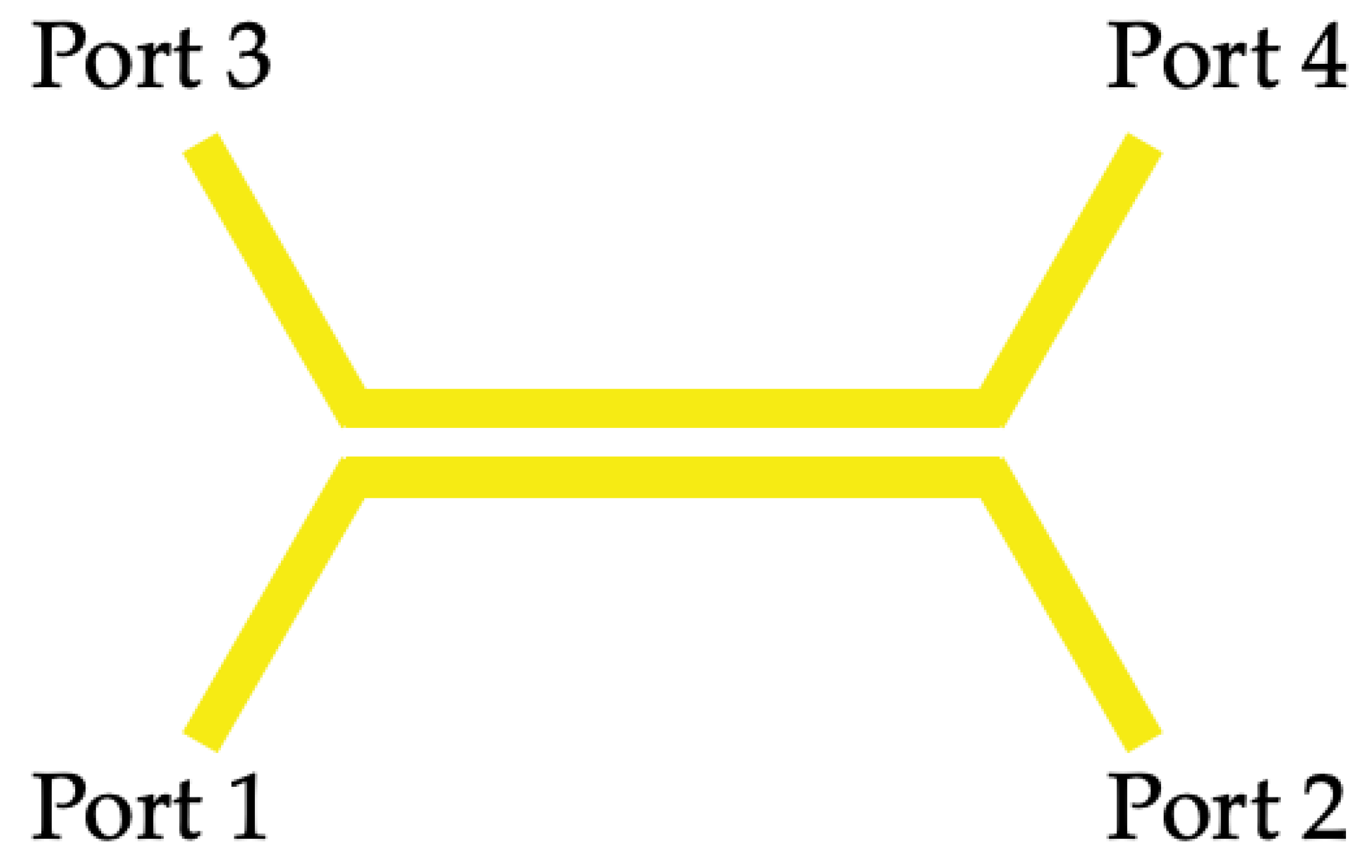

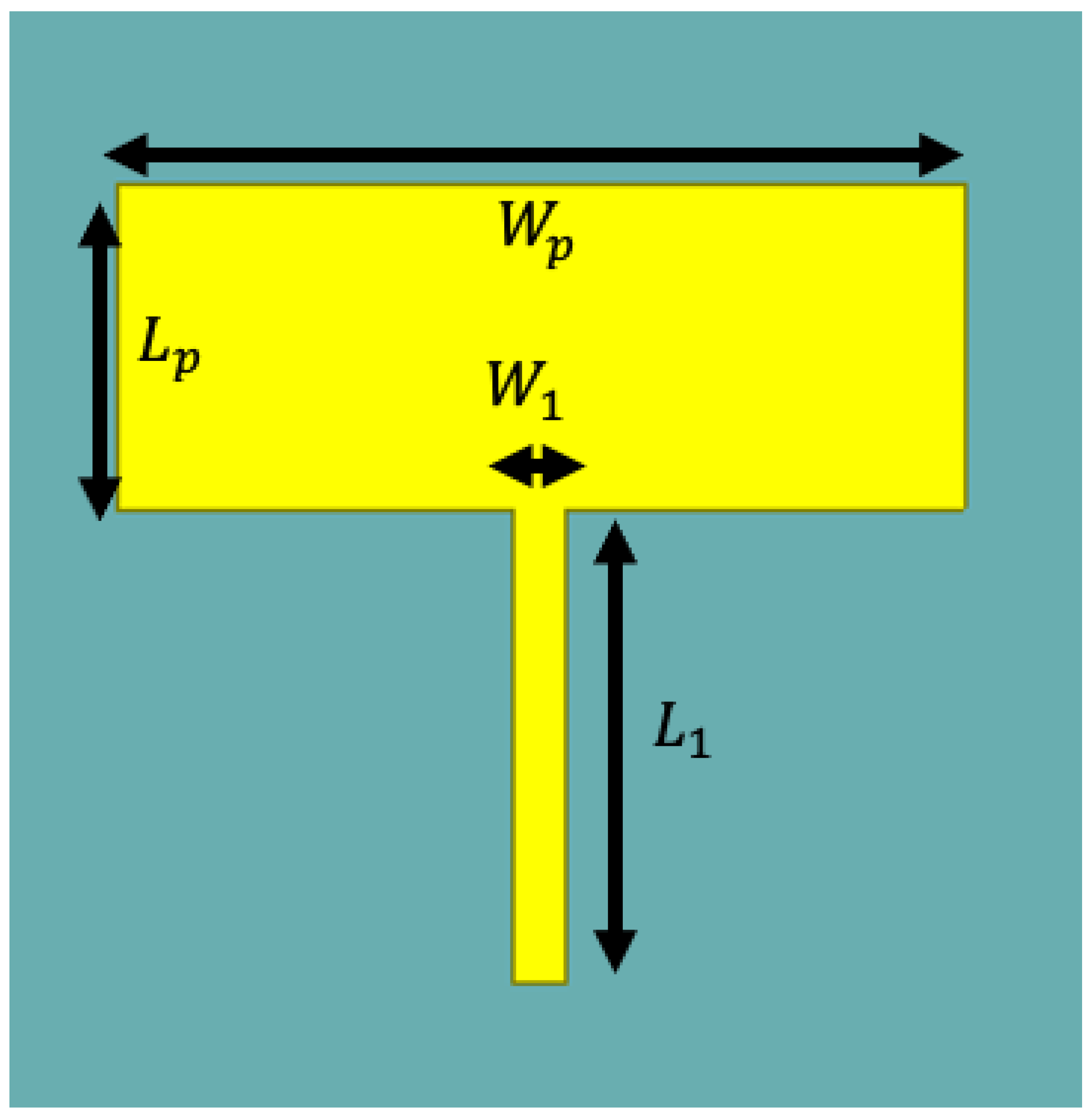
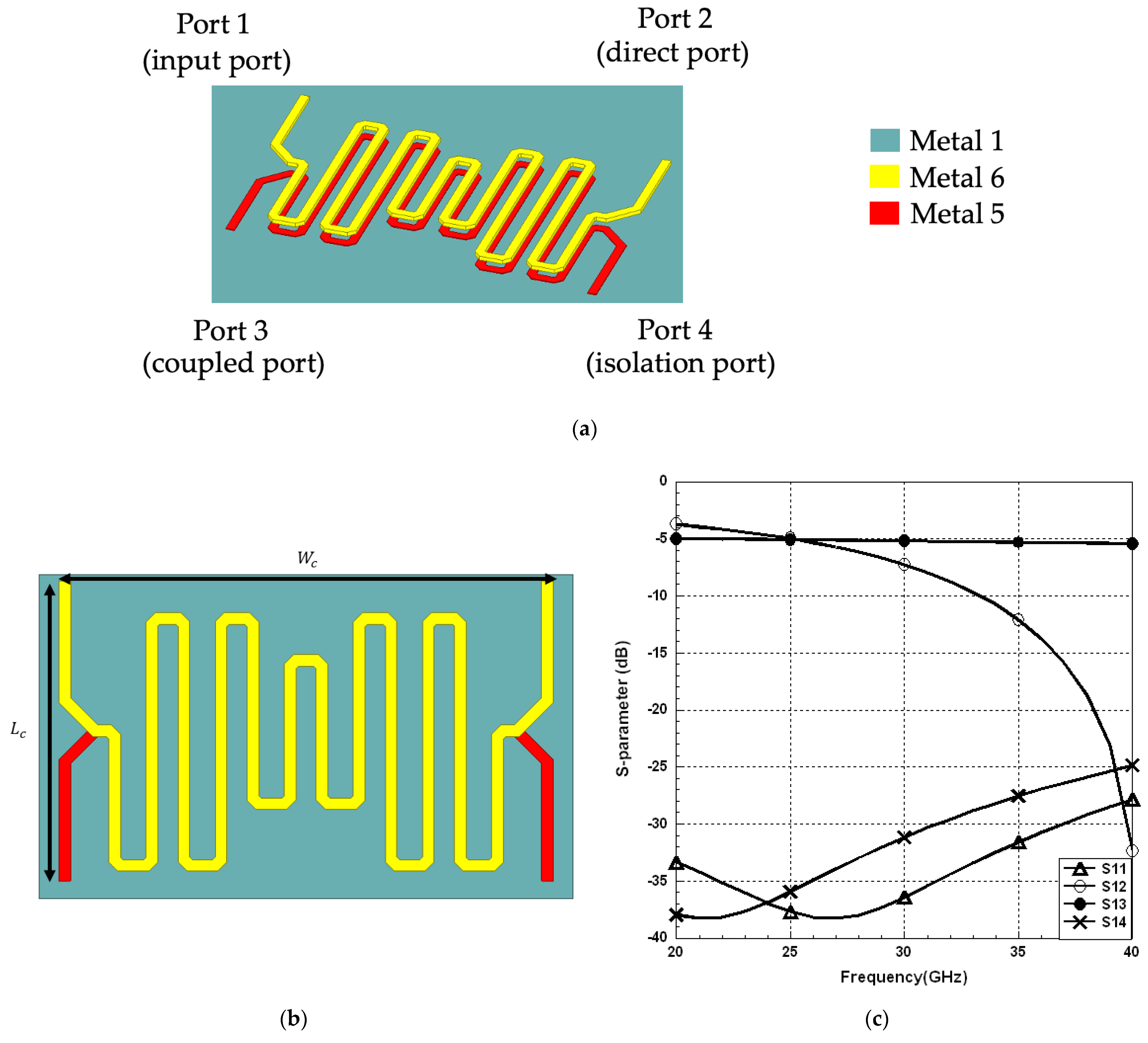

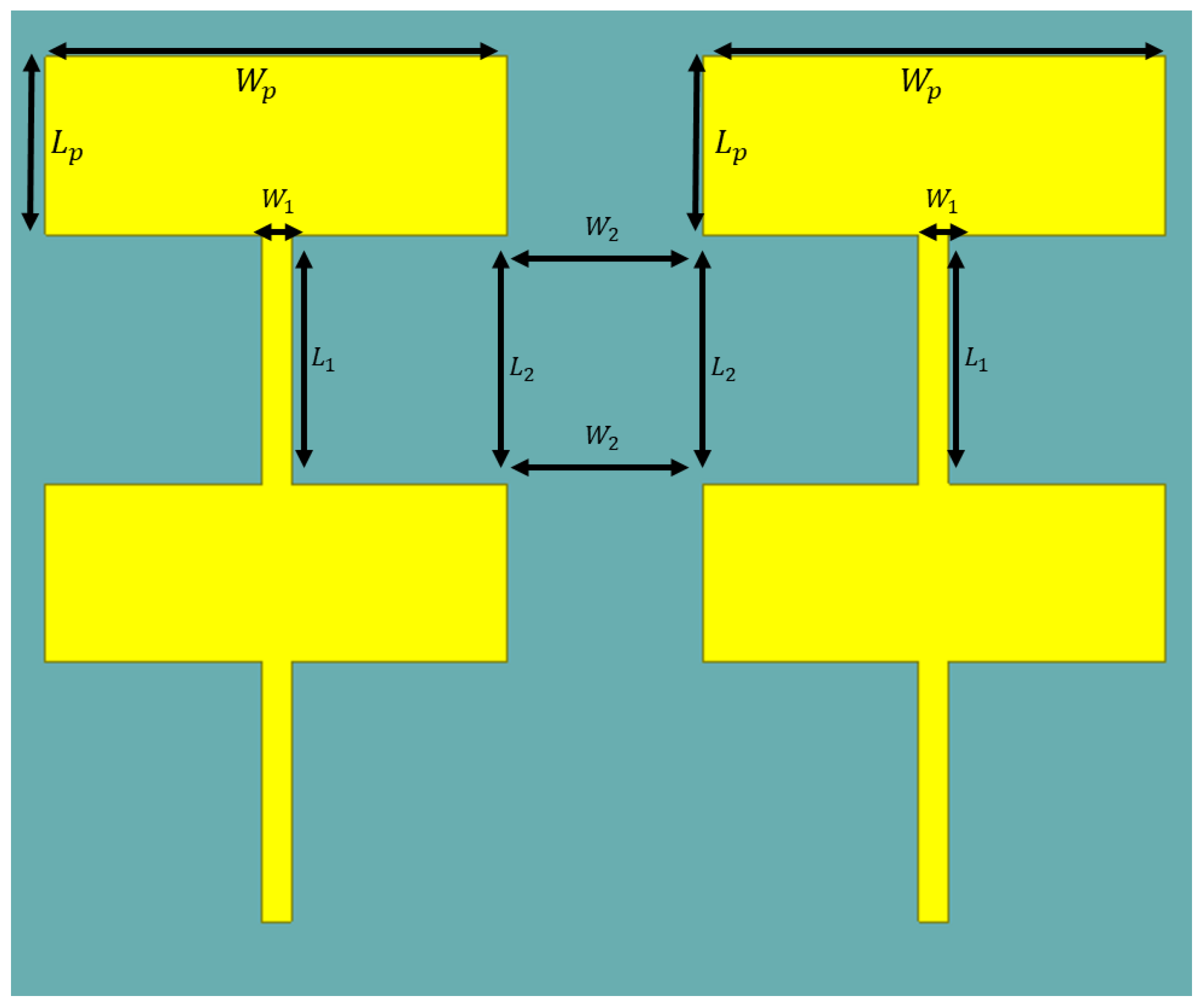




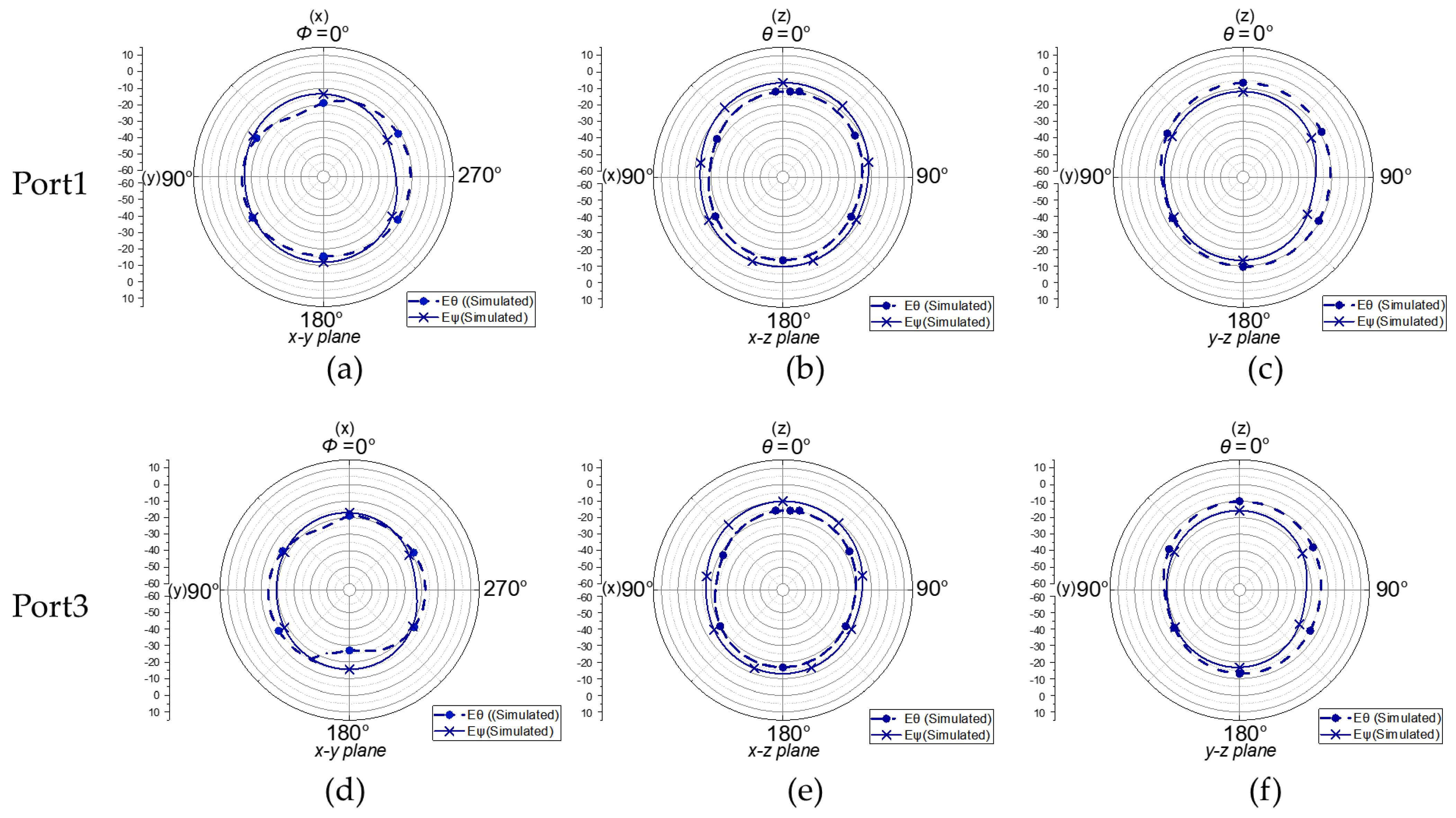

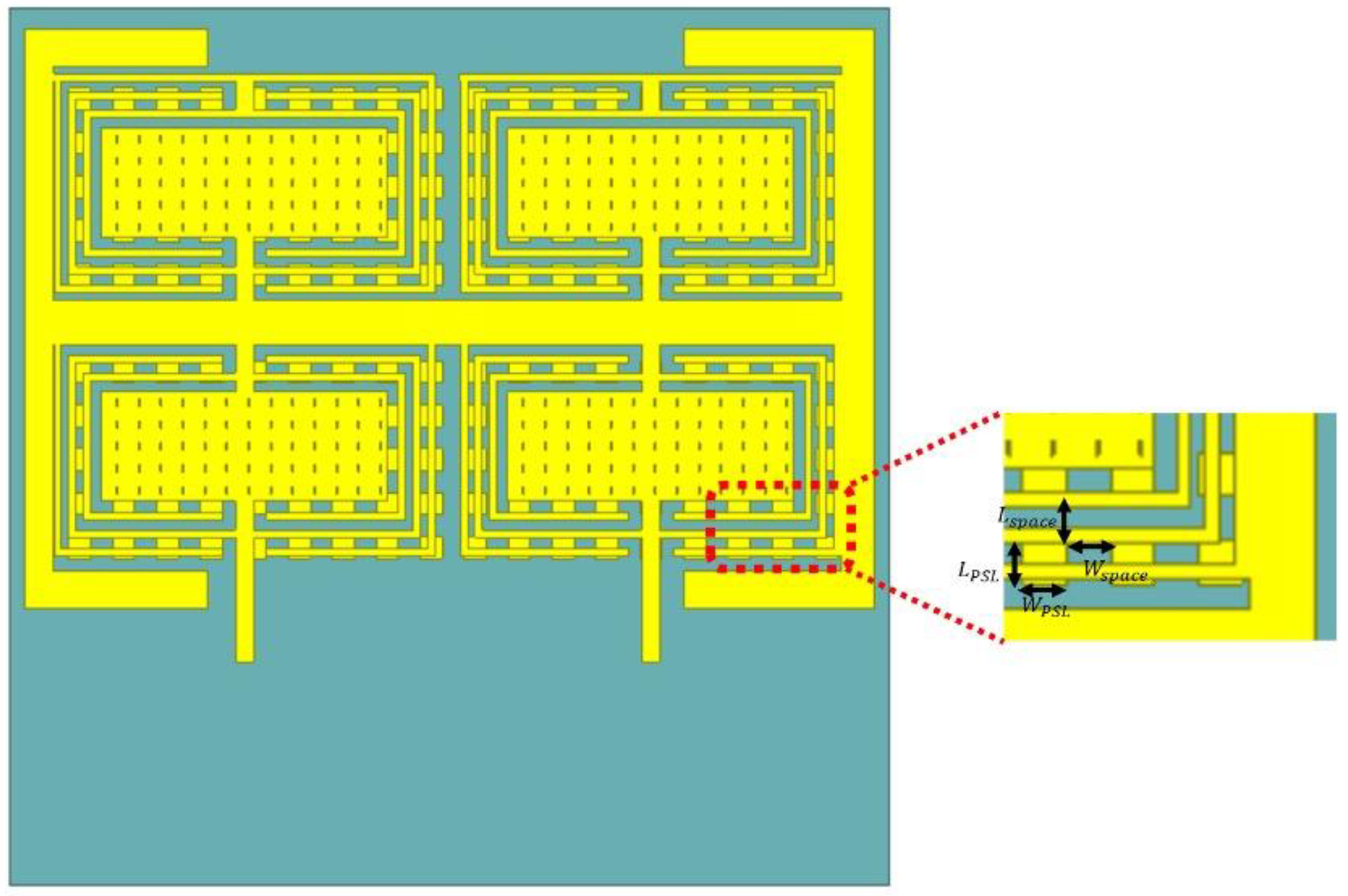
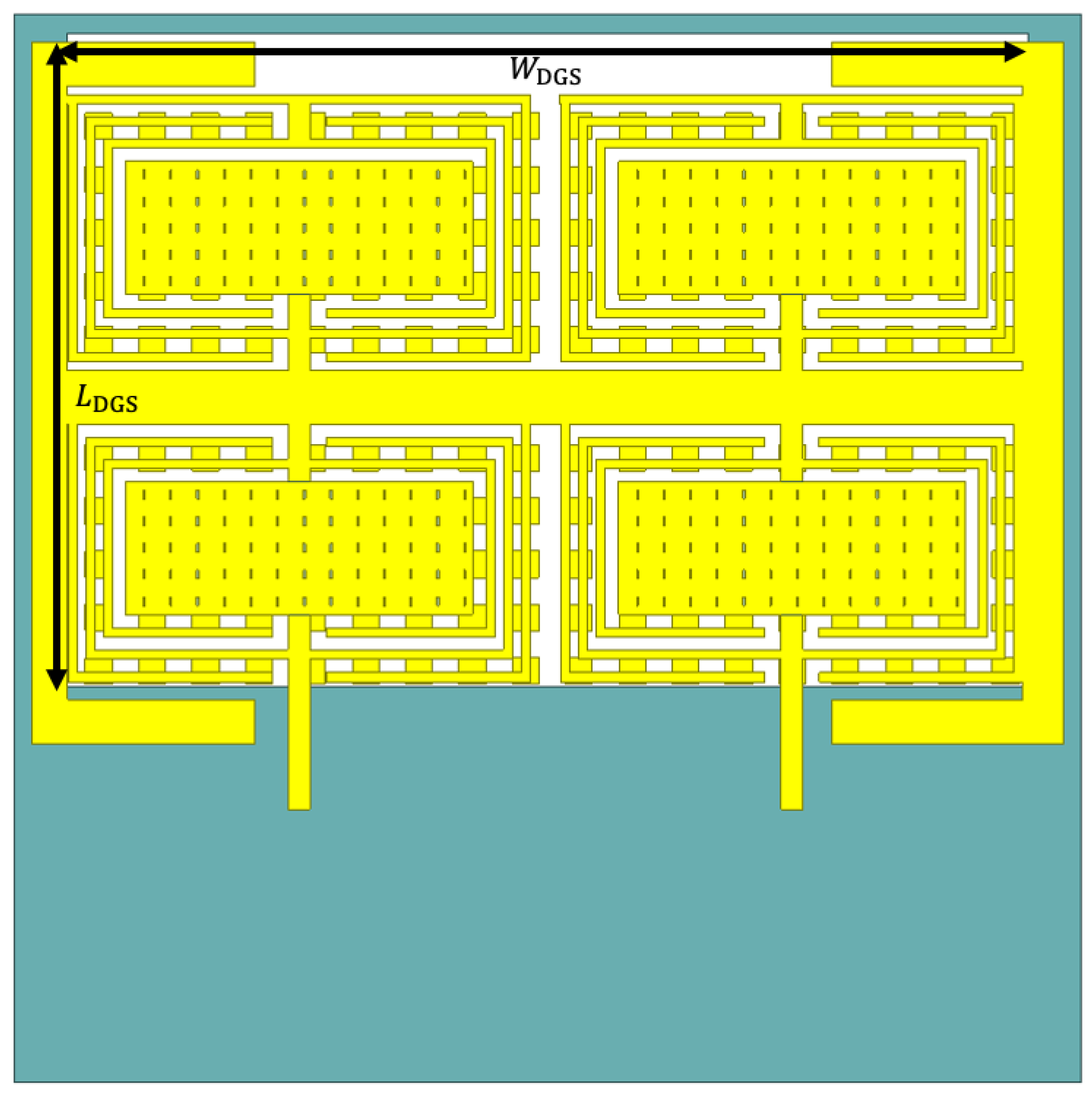
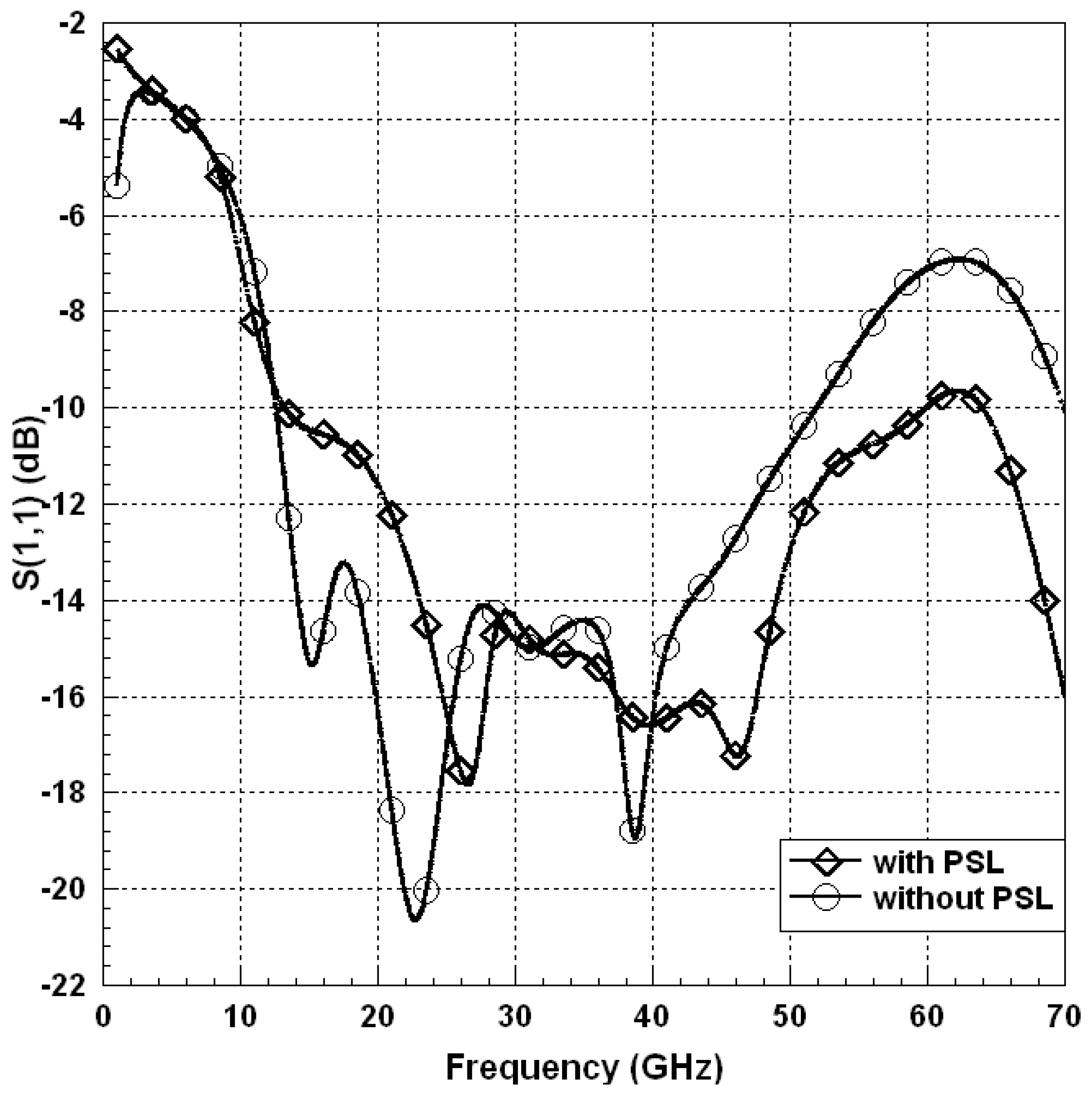
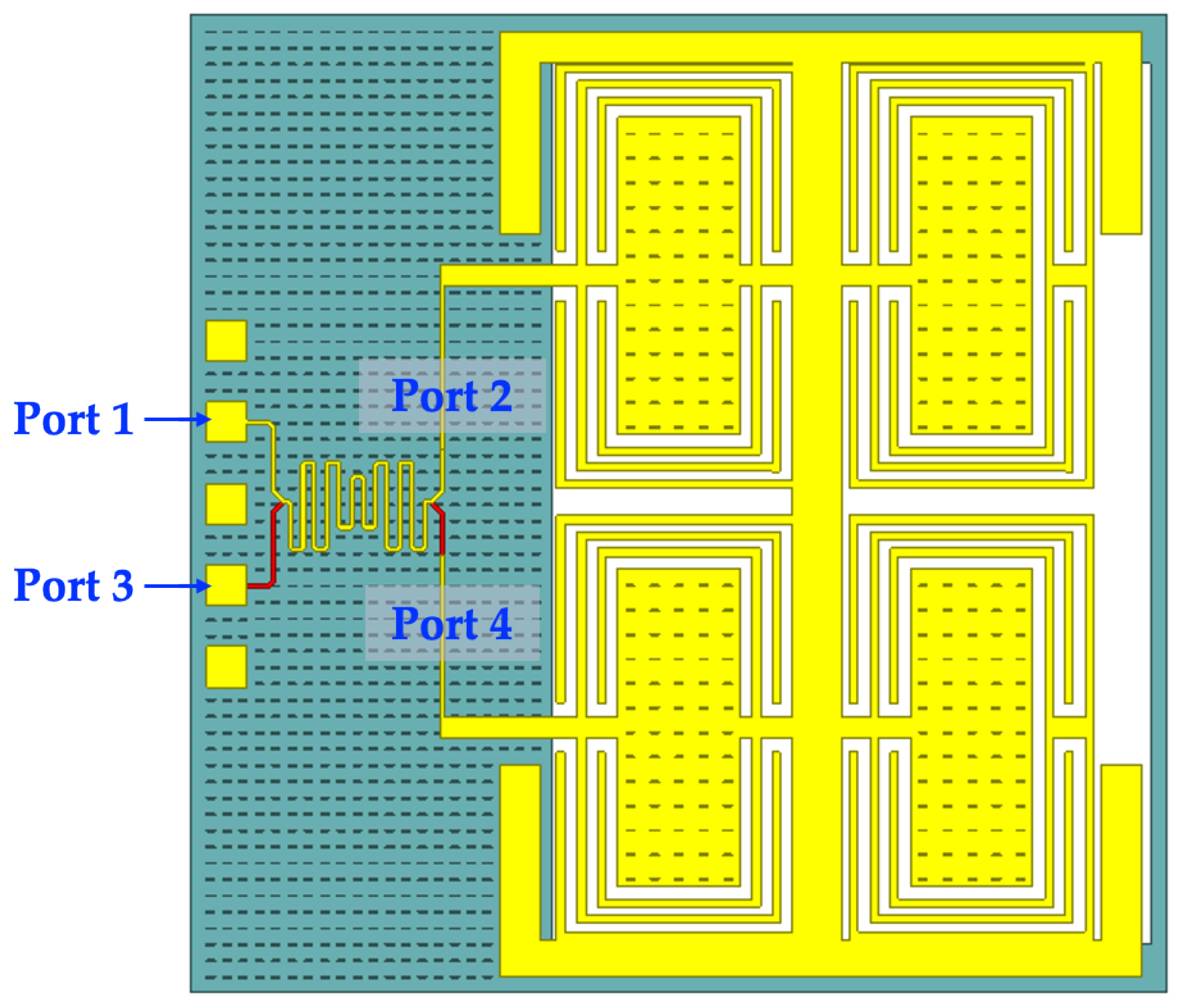

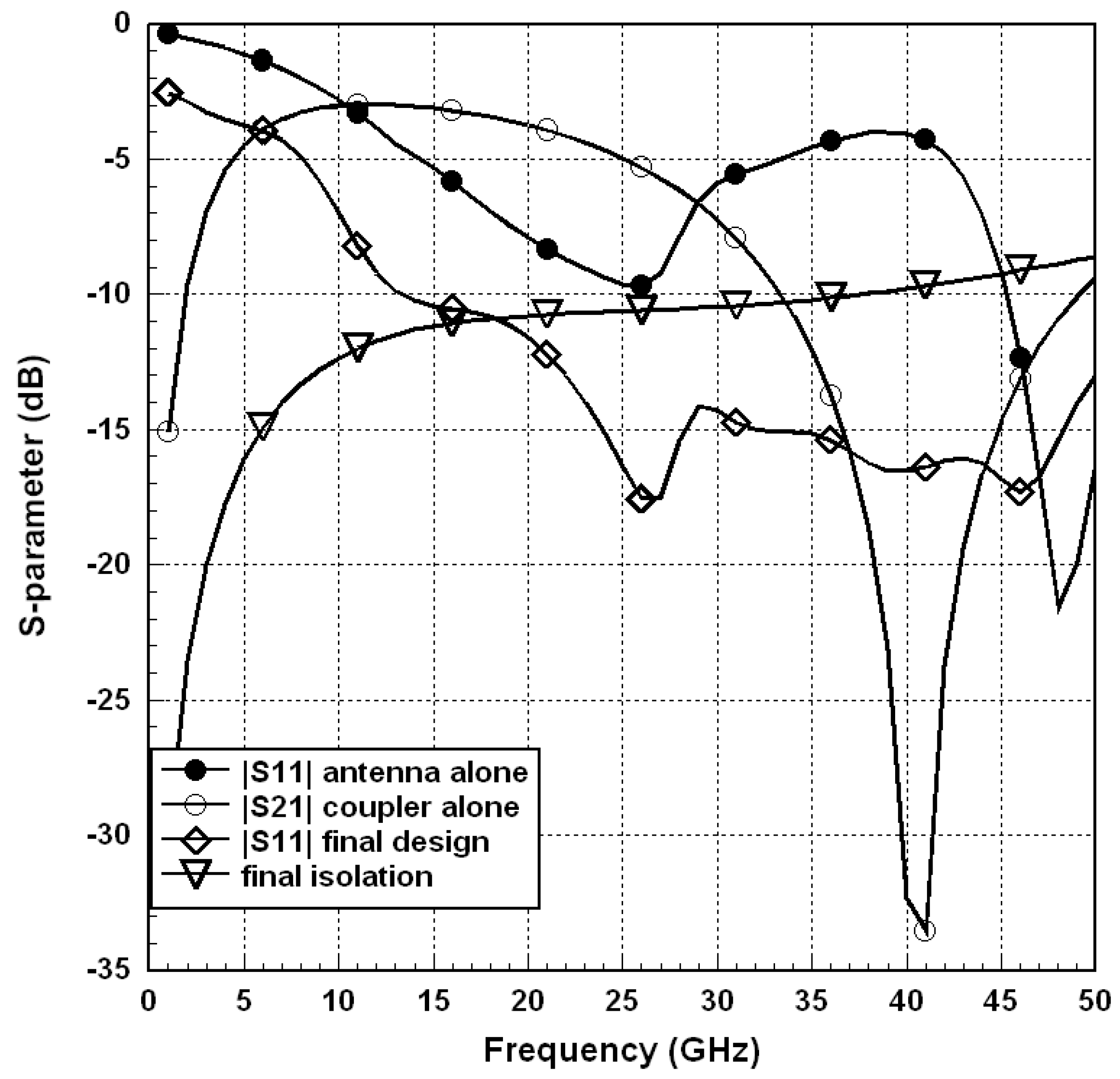

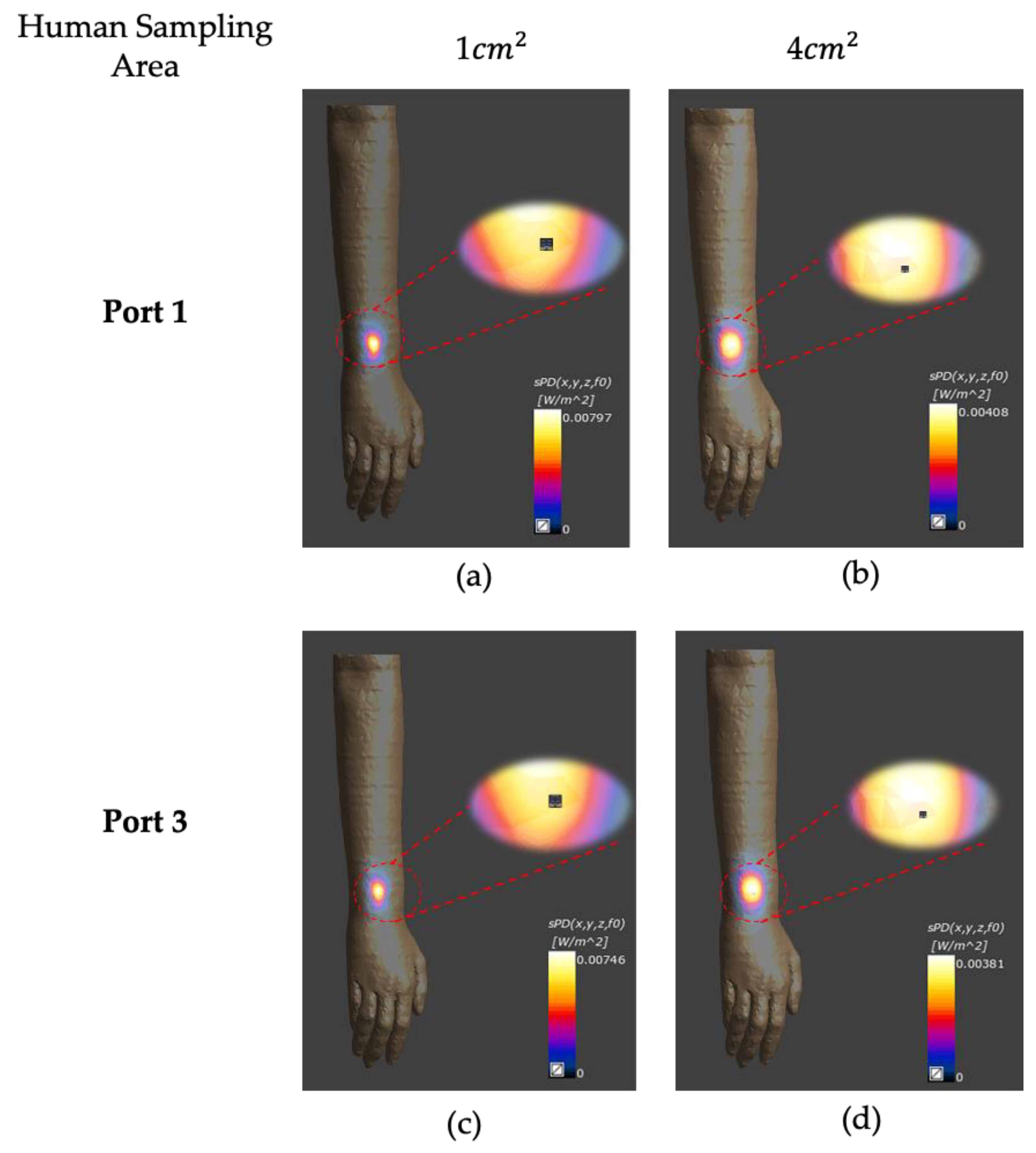

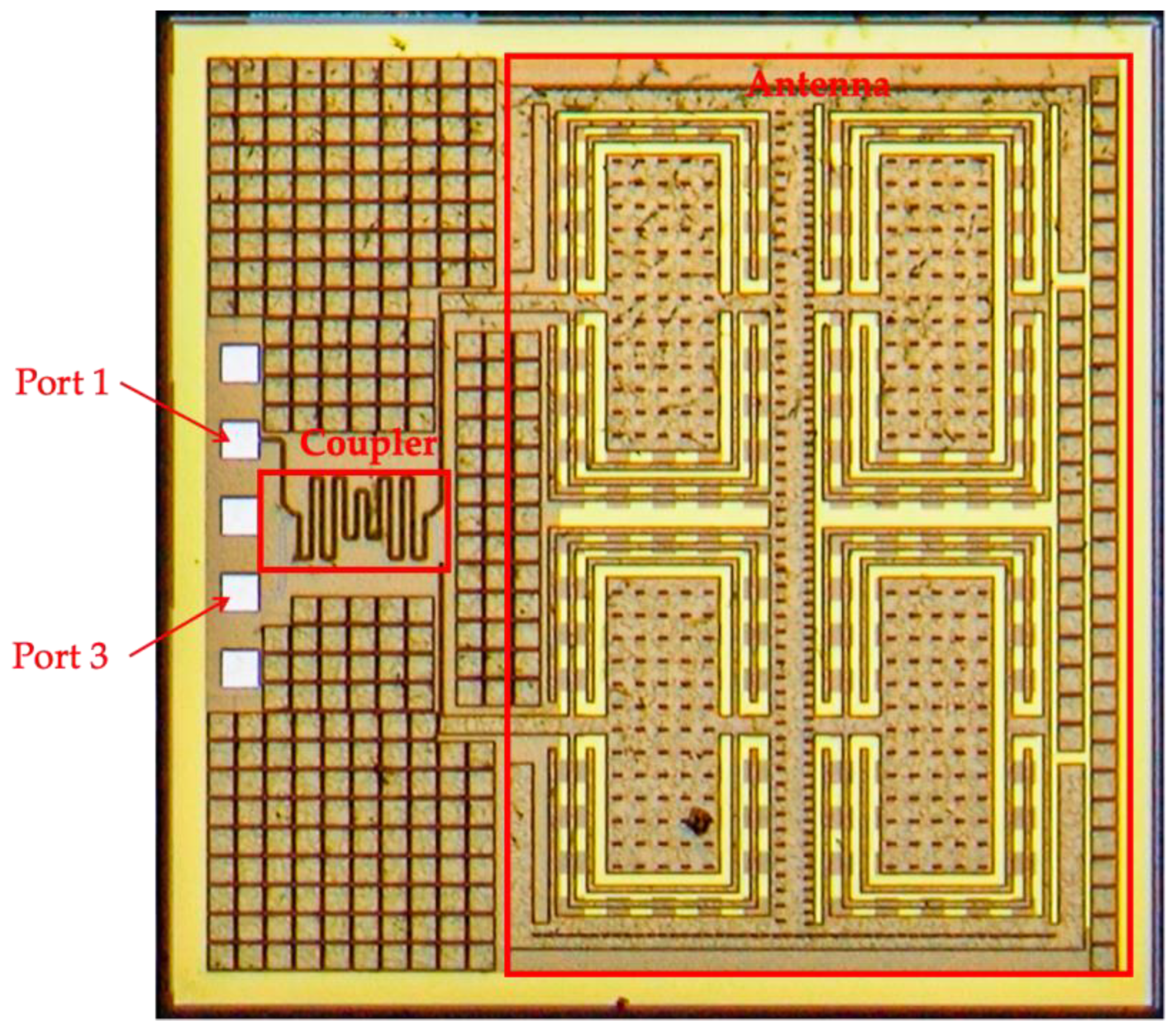
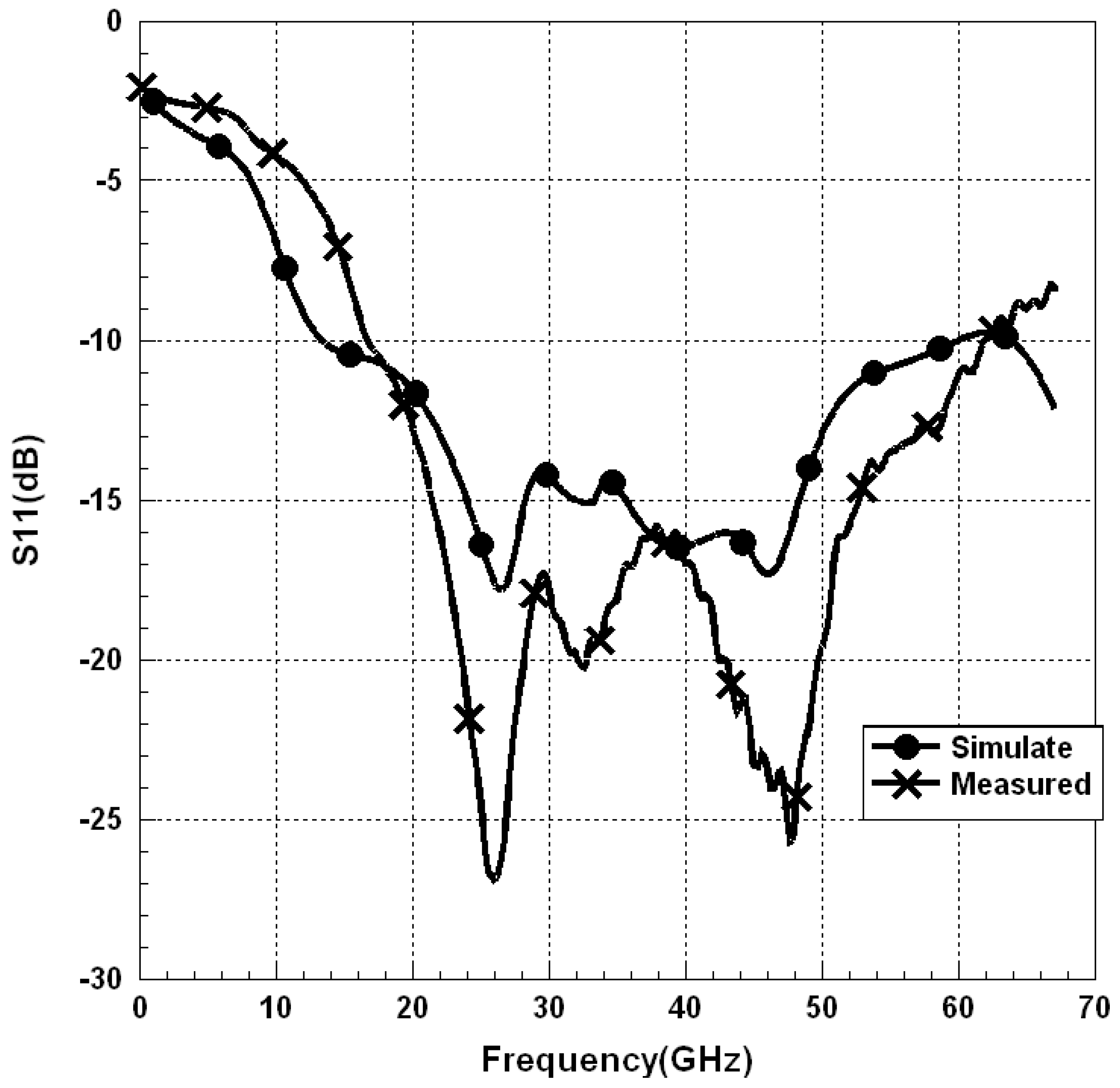
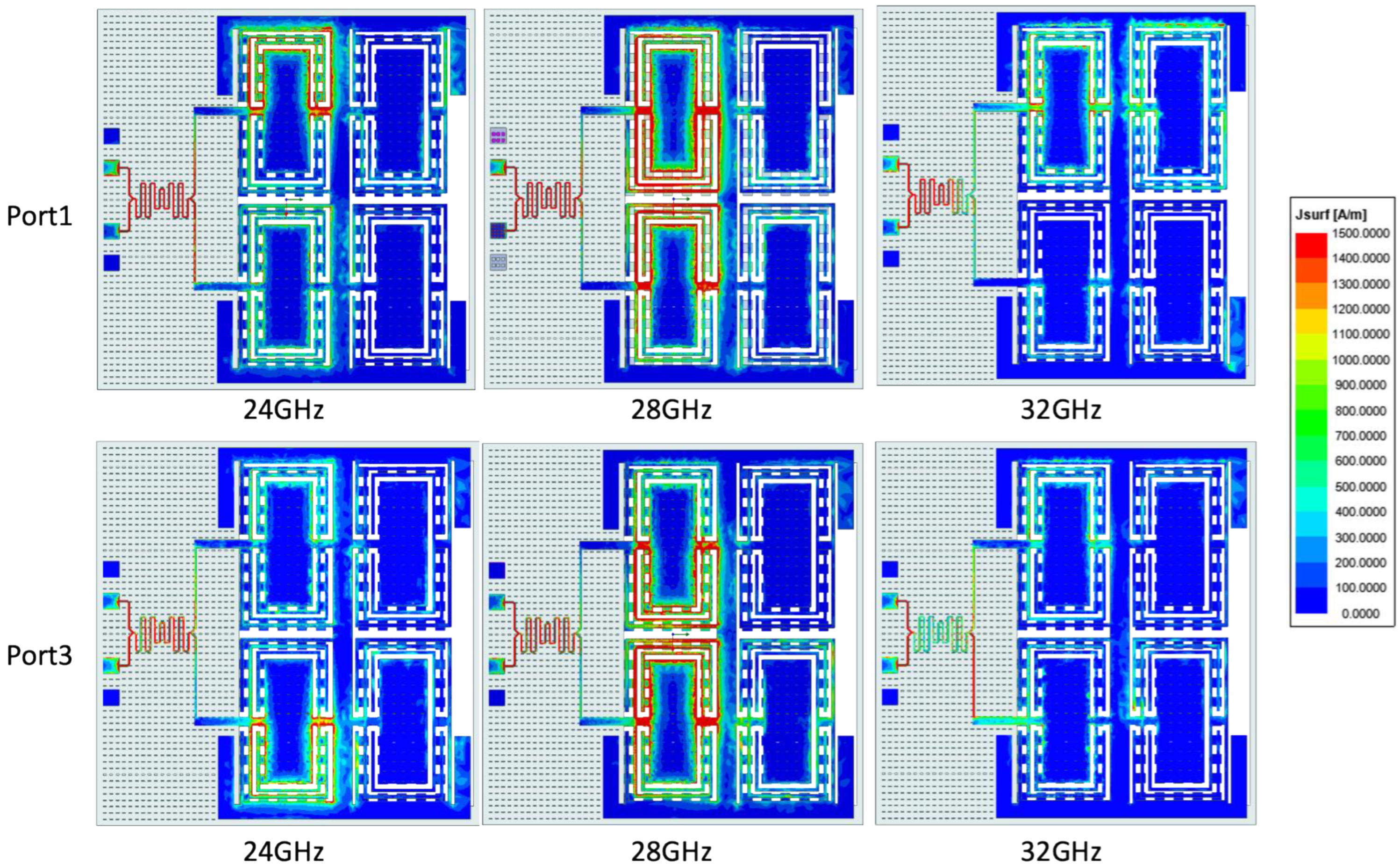
| FCC | ICNIRP | IEEE | ||
|---|---|---|---|---|
| Transition frequency (GHz) | 6–100 | 10–300 | 3–30 | 30–100 |
| Power density limit (W/m2) | 10 | 10 | 10 | 10 |
| Substrate | Coupler Type | Antenna Type | Center Frequency (GHz) | BW (%) | Return Loss (dB) | Phase Error (deg) | Overall Size | |
|---|---|---|---|---|---|---|---|---|
| Proposed | CMOS | Parallel line coupler | Patch antenna | 28 | 84.7 | 15 | 0.04 | 1.2 mm 0.216λ0 0.147λ0 |
| [73] | PCB | Rat-race coupler | Differential Feeding antenna | 30 | 27.90 | 15 | ±4 | 5.1 mm 0.51λ0 |
| [74] | 45 nm CMOS | Hybrid coupler | Array antenna | 28 | 14.28 | 15 | - | 2.6 mm 0.746λ0 0.485λ0 |
| [78] | PCB | Directional coupler | Millimeter-wave Multibeam array antenna | 30 | 13.3 | - | - | 74.83 mm 2.84λ0 11.1λ0 |
| [79] | 120 nm SiGe | Hybrid coupler | Antenna array | 28 | 24 | - | 2.3 | 3.8 mm 0.59λ0 0.56λ0 |
Publisher’s Note: MDPI stays neutral with regard to jurisdictional claims in published maps and institutional affiliations. |
© 2022 by the authors. Licensee MDPI, Basel, Switzerland. This article is an open access article distributed under the terms and conditions of the Creative Commons Attribution (CC BY) license (https://creativecommons.org/licenses/by/4.0/).
Share and Cite
Chung, M.-A.; Lin, C.-W.; Lo, W.-J. Near Field Sensing Applications with Tunable Beam Millimeter Wave Antenna Sensors in an All-in-One Chip Design. Electronics 2022, 11, 2231. https://doi.org/10.3390/electronics11142231
Chung M-A, Lin C-W, Lo W-J. Near Field Sensing Applications with Tunable Beam Millimeter Wave Antenna Sensors in an All-in-One Chip Design. Electronics. 2022; 11(14):2231. https://doi.org/10.3390/electronics11142231
Chicago/Turabian StyleChung, Ming-An, Chia-Wei Lin, and Wei-Jen Lo. 2022. "Near Field Sensing Applications with Tunable Beam Millimeter Wave Antenna Sensors in an All-in-One Chip Design" Electronics 11, no. 14: 2231. https://doi.org/10.3390/electronics11142231
APA StyleChung, M.-A., Lin, C.-W., & Lo, W.-J. (2022). Near Field Sensing Applications with Tunable Beam Millimeter Wave Antenna Sensors in an All-in-One Chip Design. Electronics, 11(14), 2231. https://doi.org/10.3390/electronics11142231






